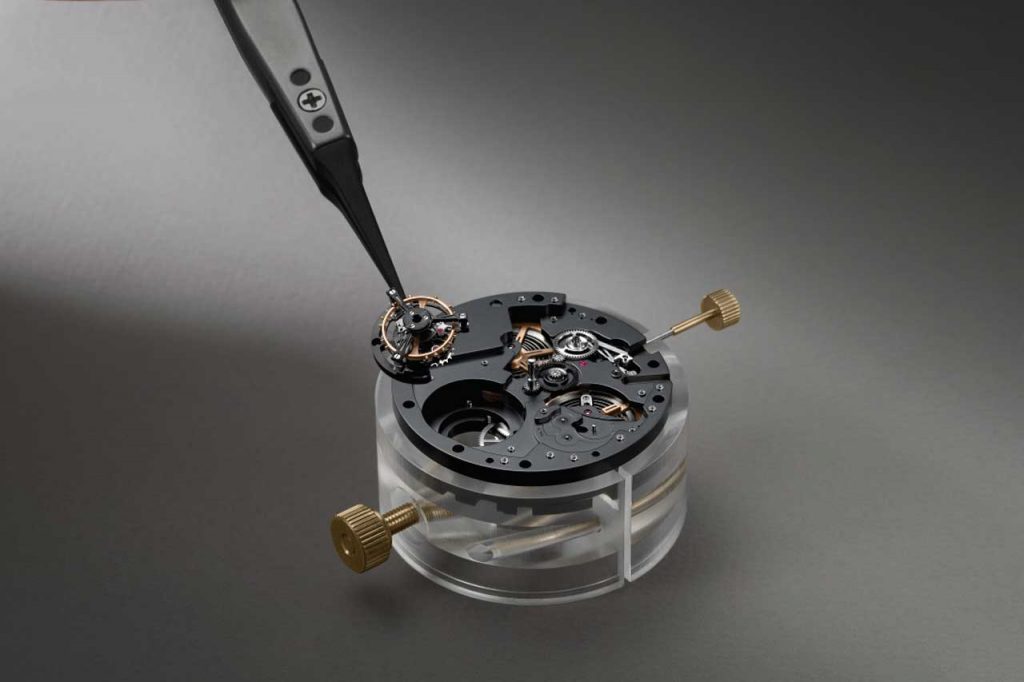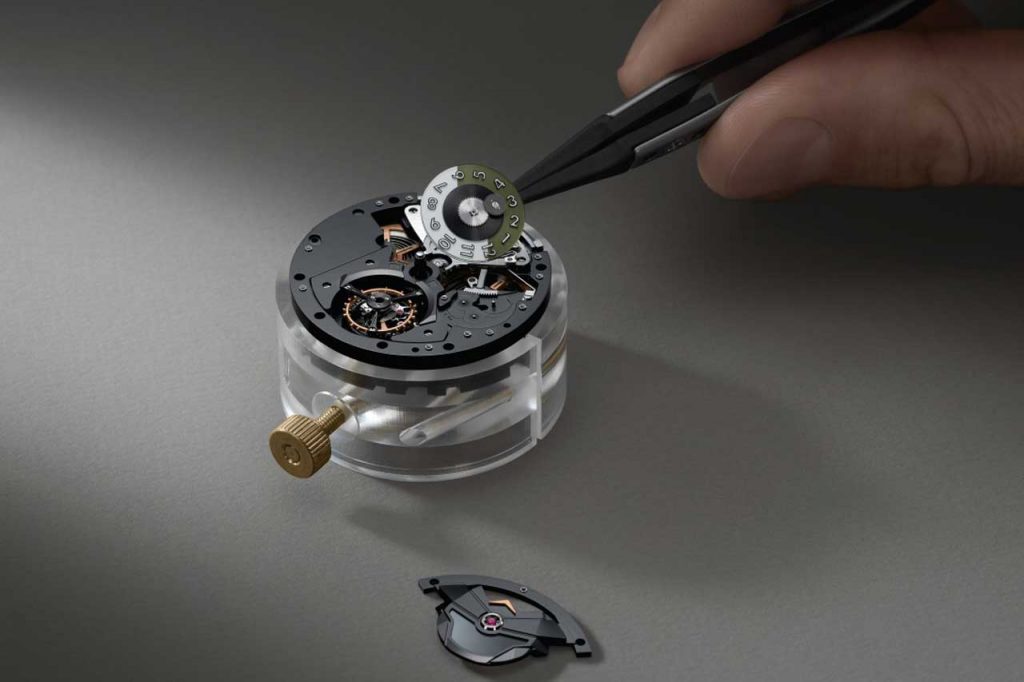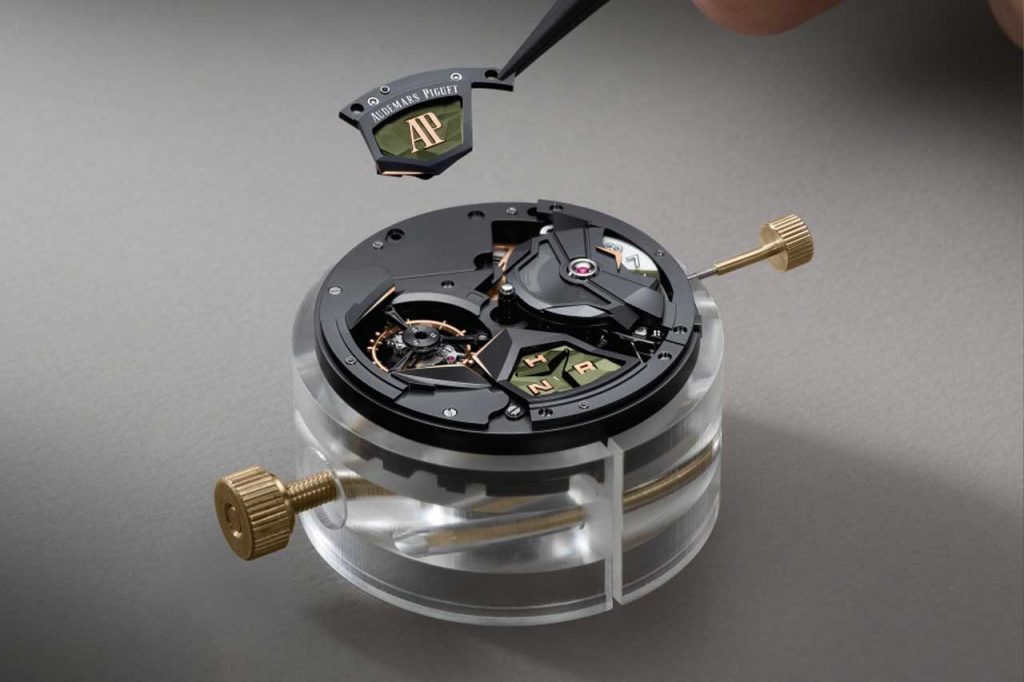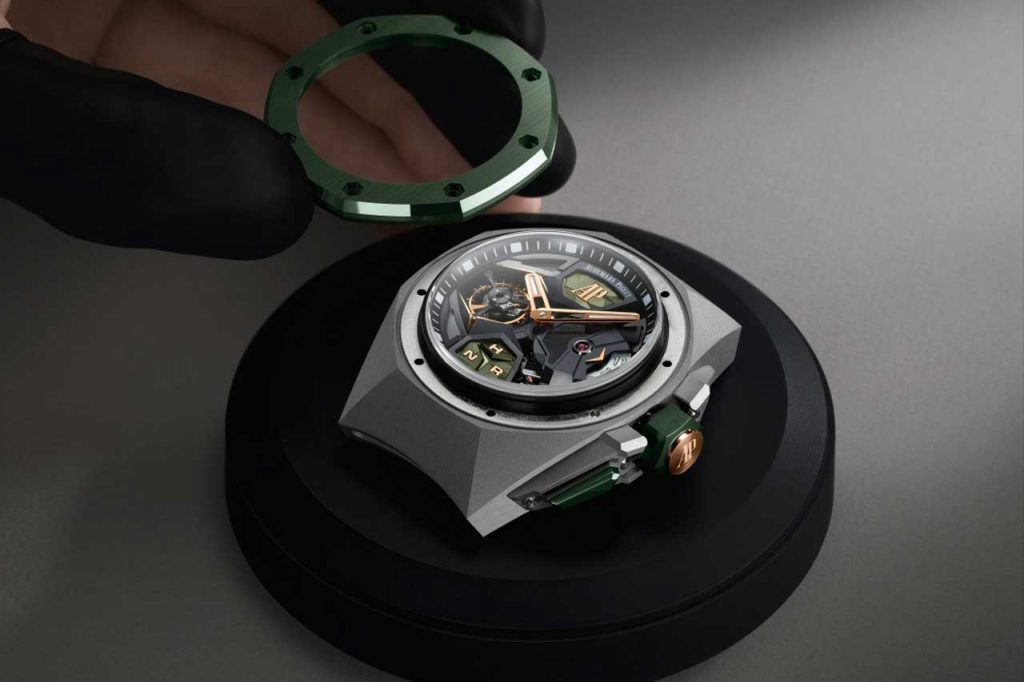Audemars Piguet Royal Oak Concept Flying Tourbillon GMT model encompasses a sandblasted titanium case enriched with a bezel, crown and push-piece, all crafted in green ceramic and finished by hand with an alternation of satin-brushing and polished chamfers. Although green ceramic was first introduced at Audemars Piguet in the Royal Oak Offshore collection in 2018, this material makes its first appearance this year on the Royal Oak Concept.
For the first time, the complicated timepiece’s titanium case is topped off with a green ceramic bezel for a highly contemporary look. The black architectural movement, visible through the dial and sapphire caseback, features green CVD-coloured inserts matching with the bezel’s hue – a powerful contrast furthering the watch’s high-tech aesthetic.
Zirconium Oxide (ZrO2) powder, modified to obtain a green pigmentation once baked, is mixed with dedicated binder content before being transformed into ceramic through a complex industrial flow requiring different stages of high-precision machining. The exact composition of ceramic remains the secret of its manufacturers. The components achieve their final green colour only once they have been sintered at more than 1,400°C. Reaching a homogeneous colour represents an additional challenge as ceramic’s final colour depends on the sintering temperature, which allows no variation. The Le Brassus artisans have then finished each ceramic component with the same detailed and meticulous hand-finished as they would if they were honed from precious metals, endowing the timepiece with a rich play of light.
As per Royal Oak Concept design codes, the architectural movement ticking within takes centre stage on both the dial and caseback sides. To further enhance the introduction of green ceramic, the hand-wound Calibre 2954 has evolved to contrast the movement’s black PVD bridges with evocative green CVD-coloured inserts. A very thin layer of green colouring, specifically developed for the occasion, has been applied by Chemical Vapour Deposition (CVD). A precursor gas is injected into a chamber, which is then heated until the gas breaks down and bonds to the surface of the different elements. In addition to offering a rich play of light, this technique ensures colour homogeneity across the components, as well as unalterable colouration over time.
The timepiece’s contrasting tones are illuminated by pink gold accents. The pink gold hands filled with luminescent coating and the applied AP monogram at 12 o’clock are echoed by the pink-gold-toned flying tourbillon cage and escapement components peeking through the openworked bridges. The transferred white hour-markers on the black inner bezel add yet another bright touch.
A green rubber strap, fitted with a sandblasted titanium AP folding clasp, completes the watch’s avant-garde design. The timepiece also comes with an additional black rubber strap.
The Royal Oak Concept saw the light of day in 2002 to celebrate the Royal Oak’s 30th anniversary. For the occasion, Audemars Piguet released a 150-piece limited edition inspired by Concept cars that combined titanium with Alacrite 602, a light yet highly resistant alloy mainly used in the aeronautical industry. While the bezel retained the Royal Oak’s trademark octagonal shape, the massive rounded 44 mm case, whose ergonomic curvature matched the natural shape of the wrist, brought this timepiece to new horizons. To complement the case’s futuristic aesthetic, the dial exposed the advanced hand-wound mechanism, while providing a variety of innovative functions: a crown position indicator, a dynamograph displaying the mainspring torque and a linear power-reserve display. The tourbillon cage and its shock-absorbing bridge was also visible at 9 o’clock.
Although originally conceived as a one-off limited edition, the Royal Oak Concept established an entirely new aesthetic for 21st-century Haute Horlogerie and led to the creation of a collection. In 2008, Audemars Piguet released the Royal Oak Carbon Concept Tourbillon and Chronograph in a pioneering case made of forged carbon, ceramic and titanium, while the movement ticking within premiered the use of carbon components. A platform of experimentation ever since, the Royal Oak Concept has seen the addition of unyielding materials, avant-garde designs and innovative complications attuned to the timepiece’s futuristic identity.
In 2011, Audemars Piguet launched its first Royal Oak Concept Tourbillon GMT in a case crafted in titanium and black ceramic. The dial showcased the openworked movement’s tourbillon cage, blackened hour-glass-shaped upper bridge, crown position and second-time zone indications. The Royal Oak Concept Tourbillon GMT witnessed another evolution in 2014 with the release of a variation uniting titanium with white ceramic.
In 2015, Audemars Piguet released the patented Royal Oak Concept Laptimer in collaboration with Michael Schumacher, the first mechanical timepiece able to measure multiple consecutive lap times on the racetrack. This watch also represented the first collaborative venture of the collection. The same year, the Manufacture unveiled its Royal Oak Concept Supersonnerie prototype, also known as RD#1. This patented technology resulted from eight years of research in collaboration with EPFL, the Swiss Federal Institute of Technology Lausanne and a host of experts, including musicians, to recover the acoustic tonality of older chiming watches.
In 2018, Audemars Piguet launched its first Royal Oak Concept Selfwinding Tourbillon Chronograph Openworked, with three models in white, blue and red hues. The same year, the Manufacture also premiered its first-ever flying tourbillon in the Royal Oak Concept collection, fitted on the first Royal Oak Concept for women – a line of powerful 38.5 mm models originally covered in diamonds. The flying tourbillon also equipped the latest GMT movement cased in a timepiece interweaving titanium and black ceramic. This new generation of Flying Tourbillon GMT powered by Calibre 2954 introduced a new movement aesthetic with asymmetrical blackened titanium bridges enriched with pink-gold-toned accents. A new version of the Royal Oak Concept Flying Tourbillon GMT followed in 2020 featuring a titanium case, a grey ceramic bezel and an architectural movement juxtaposing electric blue ALD-coloured (atomic layer deposition) bridges and slate grey inserts.
The flying tourbillon took on a marvellous air in 2021 with the release of the 250-piece limited edition Royal Oak Concept “Black Panther” Flying Tourbillon in 42 mm to mark the beginning of the brand’s long-term partnership with Marvel. Inspired by the universe of Black Panther, the watch’s case associated titanium with black ceramic in a unique aesthetic recalling the cutting-edge suit of Marvel’s hero. For its part, the dial featured a highly contemporary hand-painted rendition of Black Panther comprised of white gold.
20 years on, the Royal Oak Concept collection continues to chart new territories with new materials, colours, contrasts and more to come in 2023.
Audemars Piguet Royal Oak Concept Flying Tourbillon GMT More Information











